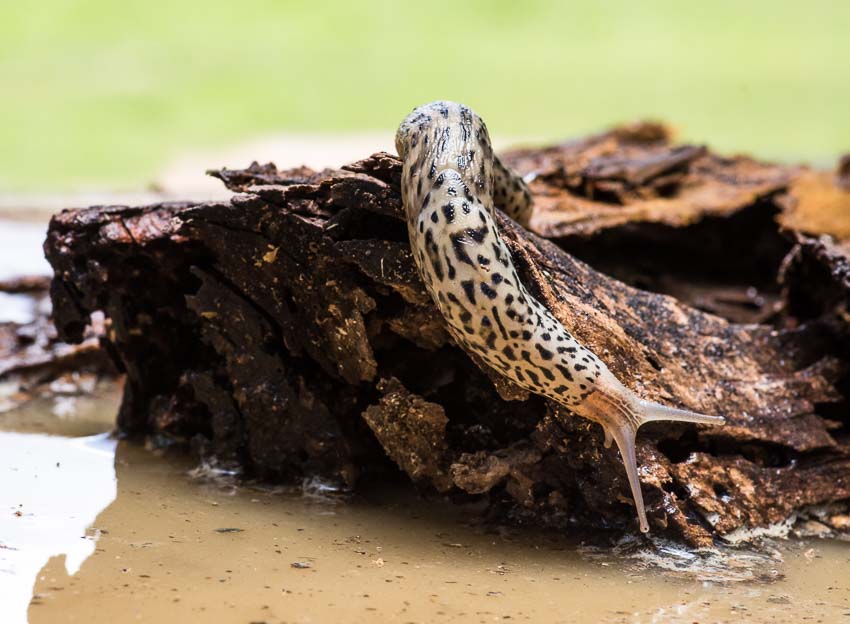Proven Strategies for Effective Slug Control
A healthy garden is teeming with life, and in many parts of the country, that includes slugs. If you find slugs in the garden, it’s time to take action and develop strategies to protect your plants. Learn how to get rid of slugs in your garden with these proven methods for effective slug control.
What are Slugs?
Slugs and snails are members of the Mollusk family , making them relatives of oysters and clams.
Like other mollusks, slugs have soft bodies, and they use tentacles for sensing and eating. They also have a foot, which is used for moving and digging.
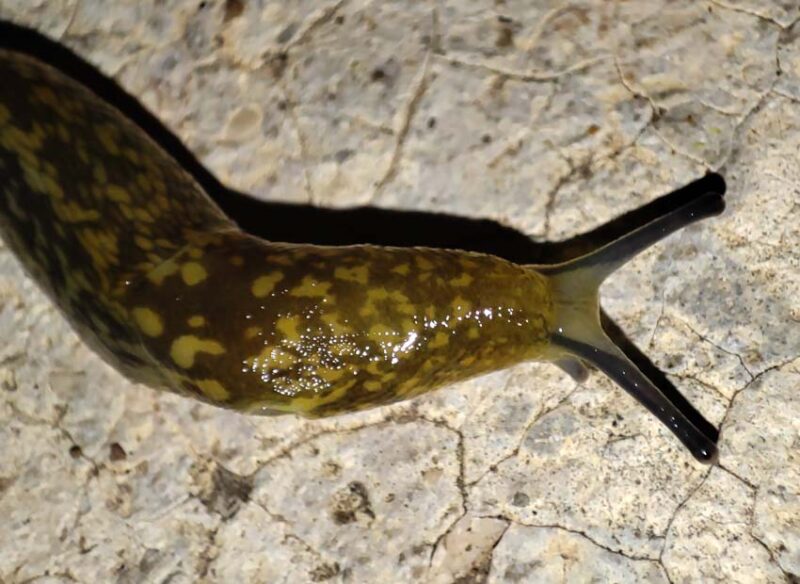
While most members of the Mollusk family have shells, slugs don’t appear to have one. However, some slugs have a vestigial shell, which is usually internal. Slugs’ bodies are made of about 80% to 90% water, making them susceptible to desiccation, which is why they are often seen after it rains.
There are thousands of slug species living all over the world, including over 2,000 species of sea slugs. Of the species that live on land, only a few are considered pests in the garden. Garden slugs help break down plant debris and organic matter in gardens, but they can also cause significant damage by eating leaves, tubers, stems, flowers, and seedlings.
What Attracts Slugs?
Moisture and food attract slugs. Because their bodies contain so much water, slugs like damp, moist areas.
They aren’t picky eaters, so all types of plants attract them, and they have a strong sense of smell, thanks to the sensitive olfactory receptors on their optical tentacles.
Ideal Slug Conditions
Slugs rely on a moist environment to protect their soft, slimy bodies. They usually come out at night because they are protected by cooler temperatures and higher humidity, and there are fewer predators.
During the day, they hide in the shade or dig into the ground and bury themselves under mulch and other types of organic litter to protect their mucus membrane.
Slugs are most active in spring when the ideal slug conditions provide them with tender new leaves, plenty of moisture, and warm temperatures. They remain active while conditions are favorable during the summer. Also, you’ll commonly see them during the fall when they come out to mate and lay eggs.
Slugs survive the winter as adults or eggs, protected underneath the soil’s surface.
Slug Foods
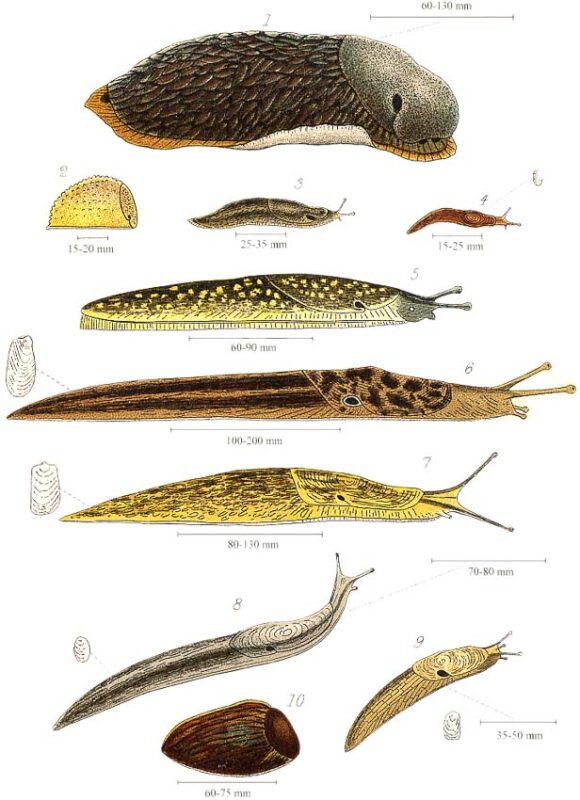
Slugs are members of Class Gastropoda, the second-largest classification in the animal kingdom. The term “gastropod” means “stomach foot,” and the species in this class have a simple anatomy and an indiscriminate appetite.
Slugs will eat almost any type of plant, which is bad news for gardeners dealing with a slug problem. They feed on decayed organic matter, soil microbes, fungi, and earthworms.
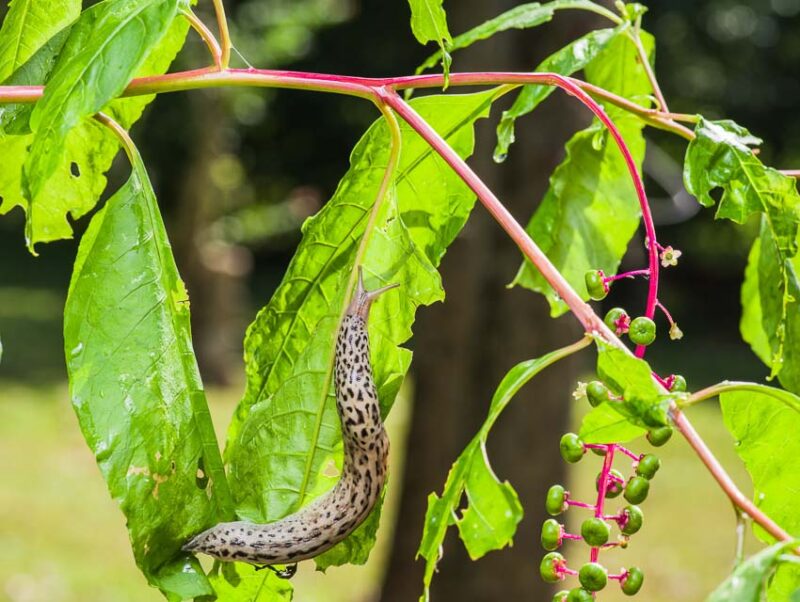
While not all species of slugs are plant eaters, garden slugs will feast on all parts of a plant above and below the surface of the soil. They cause the most damage to young plants and plants with tender new growth, but they can also devastate gardens by eating fruits, roots, tubers, and bulbs.
Are Slugs Harmful?
Getting rid of slugs is critical because they can cause considerable damage to crops.
They are generally harmless to humans. However, health risks are associated with ingesting slugs as they can transmit diseases, which can be transferred through their slime.
Damage Caused by Slugs
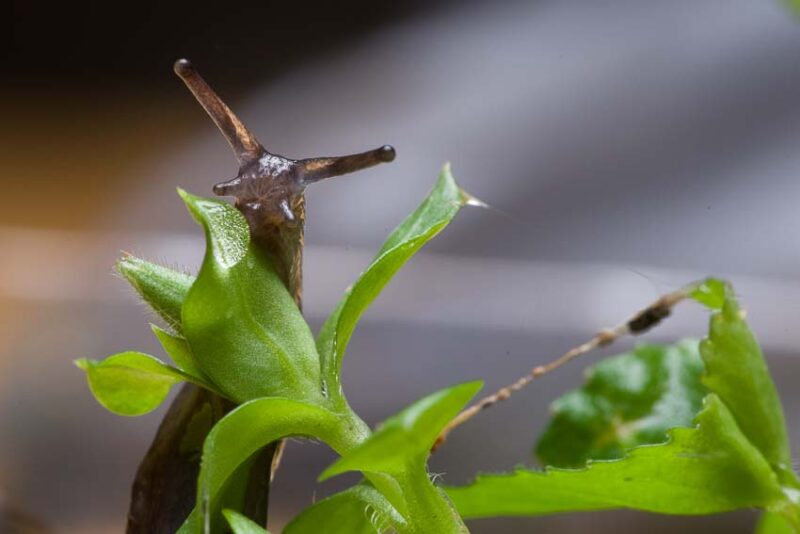
Unlike many insects with mandibles that take bites out of plants, slugs leave ragged and irregularly shaped holes in leaves.
Instead of a mouth, a slug has a jaw and a radula. The radula is similar to a tongue, but it is covered in thousands of microscopic teeth-like denticles.
Slugs use their radula to scrape or rasp plant leaves and other food particles and shred them into tiny pieces. Then, they draw these food particles into the esophagus and stomach.
Slugs are opportunistic feeders, and they will feed on seeds, seedlings, and plants of all sizes, including taking bites out of fruit.
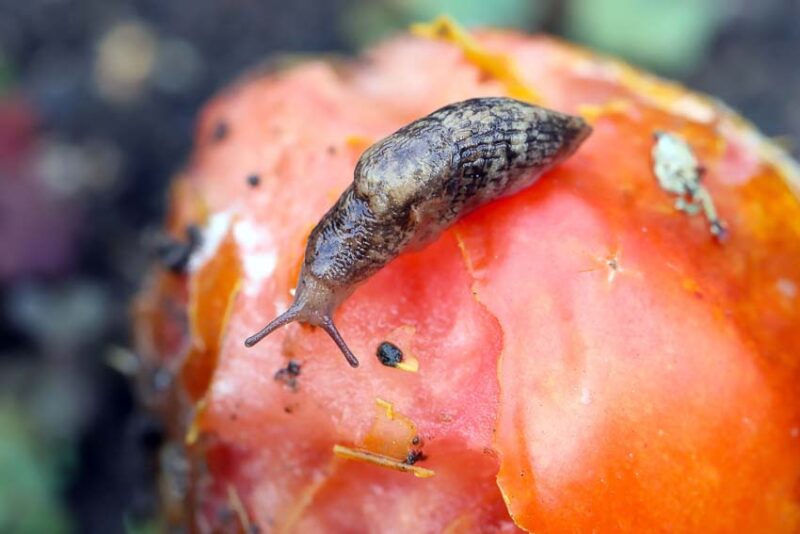
The first signs of damage caused by slugs are unsightly, but they won’t necessarily affect the health of a plant unless it is a small seedling. However, it can make them more susceptible to diseases.
Severe infestations of slugs cause more significant damage to garden plants and field crops as they strip away more plant tissue.
Diseases Transmitted by Slugs
Most people are disgusted by slugs, and for good reason.
They host several types of bacteria, nematodes, and other parasites, including flies. Slugs can transmit diseases when ingested, intentionally or accidentally. This transmission occurs via their slime when it comes in contact with your skin or when you ingest unwashed vegetables.
Furthermore, after consuming infected rat feces, that rat lungworm often infects slugs. Rat lungworm, or Angiostrongyliasis, is a roundworm parasite passed from slugs to humans and pets.
Rat lungworm causes eosinophilic meningitis, which affects the brain and spinal cord, leading to comas and death in severe cases.
Although rare, all cases of rat lungworm in humans can be traced back to snails and slugs, so it’s best to wash your hands after coming in contact with slug slime and avoid handling or ingesting them.
Are Slugs Helpful?
It might seem like slugs are all bad, but there are many ways that slugs are good for the ecosystem.
Slugs as Decomposers
Slugs feed on a variety of dead organic matter and promote decomposition, which can improve the health of your soil. They feed on leaf matter, animal droppings, carrion, and rotting plants and help convert nutrients back into the soil.
Because slugs ingest microbes, they are important vehicles for dispersal of microorganisms. This dispersal, defined as the movement of species across space and time, is important for balancing the ecosystem and connecting regional groups of microorganisms.
Slugs as Prey for Other Species
Slugs are food for many species, and they are hosts for many different types of microbial parasites, such as nematodes and bacteria.
Here is a list of some of the species that prey on slugs:
- Mammals–shrews, voles, moles, mice, rats, groundhogs, squirrels, hedgehogs, badgers, and foxes
- Reptiles and amphibians–snakes, salamanders, toads, and turtles
- Birds–Starlings, blackbirds, ducks, geese, grouse, thrush, wild turkeys, and robins
- Insects–Ground beetles, carrion beetles, fireflies, centipedes, and horn flies.
Domestic animals, like cats and chickens, also prey on slugs.
Effective Ways to Get Rid of Slugs
There are many ways to get rid of slugs, but because they are important to a balanced ecosystem, it’s not a good idea to try and eliminate them completely. Using proper garden care and maintenance alongside natural repellents, you can minimize the potential for slugs to cause problems in your garden.
Garden Maintenance and Protection
Use the following garden maintenance and care practices to make your garden less attractive to slugs.
Proper Watering Techniques
The ideal conditions for slugs are warm and moist, and they are most active at night, so anything you can do to stop providing them with ideal conditions for moving around will help. Avoid watering your lawn and garden late in the day, and use a drip irrigation system that waters plants at the roots and keeps the foliage dry.
Effective Garden Layouts
Change your garden layout to help get rid of slugs.
Start by spacing garden plants farther apart. When plants are grown close together, it gives slugs a chance to move around and stay hidden from predators. They can go from plant to plant without ever coming out of hiding.
You can also try using raised beds to prevent slugs from causing damage to your garden. While raised beds won’t prevent slugs, they make it easier to keep them out. Paint the walls of your raised beds with slug-repellant paint and install slug fences to keep them from moving freely into your garden beds.
Getting rid of slugs with natural repellents
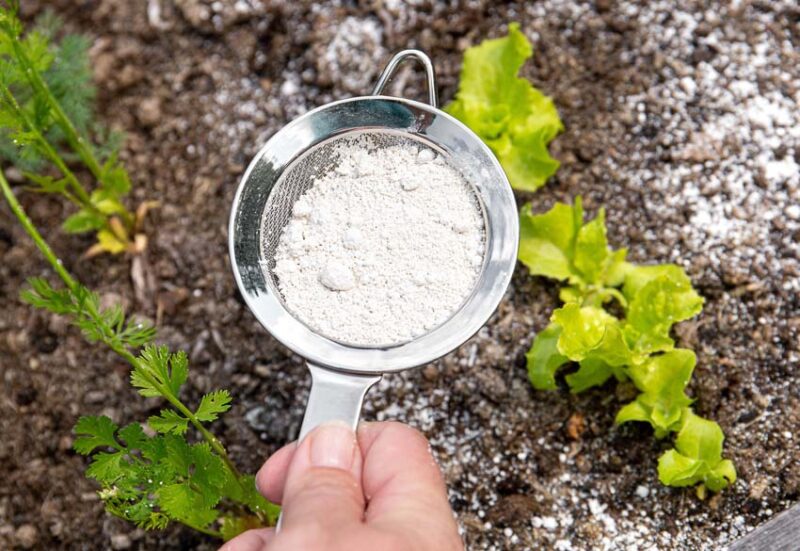
Fortunately, there are many natural slug repellents that you can use. Here are some of the most effective natural repellents for keeping slugs away from your garden plants.
- Diatomaceous earth–comprised of fossilized shells, it acts like tiny shards of glass, which cut through the soft body of slugs and kill them
- Eggshells–the sharp edges of crushed eggshells will repel slugs
- Sand, gravel, and wood ash–are uncomfortable for slugs to creep across and can dry them out
- Coffee grounds–the caffeine in coffee grounds is toxic to slugs
- Copper–a chemical reaction between copper and slug slime keeps them away
Many plants are also effective slug deterrents. Plant herbs like fennel, anise, rosemary, mint, and rue repel slugs. You can also plant members of the allium family, such as onions, chives, garlic, and leeks.
Strong-smelling plants like geraniums and poisonous plants like foxglove are also effective natural slug repellents.
Non-Chemical Slug Control Methods
Slugs can be bad for your lawn and garden, but before using harmful chemicals, try these homemade traps and biological control methods to get rid of slugs in your yard.
Homemade Traps
Some of the most effective methods for getting rid of slugs is homemade traps. Since slugs are focused on food, moisture, dark hiding places, and smells, it’s easy to make homemade traps to catch them.
Beer traps
Slugs are attracted to the fermenting yeast in beer. Place a shallow plate of beer near your plants, and they will drown in it. You can also use yeast, water, and sugar for the same effect.
Hole traps
Dig several 4” x 4” holes in your garden beds and place a piece of cardboard over each one. In the morning, you can find slugs hiding in them.
Newspaper traps
You can lay down pieces of newspaper, cardboard, or asphalt shingles and the slugs will crawl under them to escape the heat. Then, it’s easy to lift them up and destroy the slugs.
Luring slugs away from your garden
Slugs are attracted to citrus, and you can lure them away from your seedlings by leaving citrus rinds and leaves scattered around in areas where they won’t harm your succulent and tender plants.
Biological Control Methods
Handpicking slugs is one of the simplest biological control methods, but you should wear garden gloves and wash your hands after handling them. If the thought of touching them disgusts you, salt is a powerful desiccant, and it’s easy to kill slugs by sprinkling a dash of salt on them.
Putting up birdfeeders or installing a pond will attract the natural predators of slugs. Many people also let their ducks and chickens into their gardens to feast on slugs. Phasmarhabditis hermaphrodita, a nematode, is another common biological control that people use to control slugs.
Chemical Slug Control Methods
How do you get rid of slugs permanently? If you have a slug problem and you’re trying to grow a large market garden or crop, chemical controls might be your best option.
Commercial Slug Baits
Molluscicides, like iron phosphate and niclosamide, are the active ingredients in commercial slug baits and pellets. They combine them with food particles to attract slugs, and after the slug consumes them, the chemicals upset the water balance in its body.
Slugs stop feeding and go underground to die, so the only way you can tell if slug bait is working is if there is less damage to your plants.
Appropriate Use of Slug Pesticides
Be sure to remember that regular pesticides are not effective at controlling slugs. You must use molluscicides, which are pesticides that target mollusks. They are harmful to other animals, and you should use them with caution.
Metaldehyde was used for decades to control slugs, but it’s now banned due to its toxicity to wildlife. It is also extremely harmful if humans and pests inhale or ingest it. Contact your local waste management facility before disposing of old metaldehyde pellets.
Final Thoughts on Getting Rid of Slugs
Slugs are disgusting and annoying pests that can cause a lot of damage, especially in the spring. However, they are also important for keeping the ecosystem balanced.
By following best practices for watering your garden and being diligent about putting out homemade slug baits, you can keep them from destroying your plants and garden crops.

